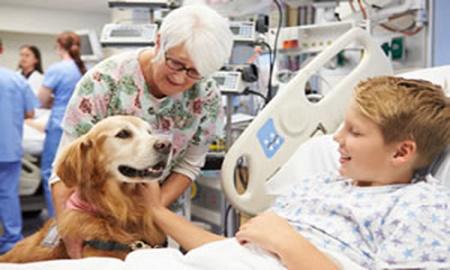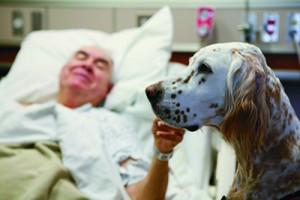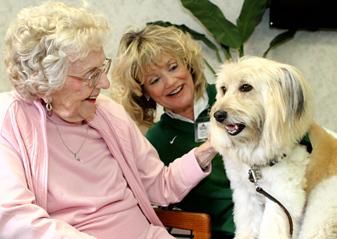Have you ever had to spend any time in the hospital as a patient? If you have, it is likely that you may have experienced periods of feeling low, anxious, stressed, and frustrated as a result of your illness or injury and because of being away from family, friends, and your home. If any of this sounds like your hospital experience, you were not alone, as it is not uncommon for hospitalized patients to experience a downturn in mental wellbeing, sometimes with physiological changes too.
In order to counteract some of these multi-factor stressors that hospitalized patients experience, many hospitals have introduced a variety of therapeutic programs. One program that you are increasingly likely to see on that list is animal-assisted therapy sometimes simply called pet therapy.
Why is animal-assisted therapy being used?
The idea of animal-assisted therapy is not new. For many years, it was considered to be a “nice” thing for hospital patients to experience, but thanks to increasing amounts of research into the topic by clinicians, there has been proven to be a wider range of benefits.

What are the benefits of animal-assisted therapy to patients?
An article by Cole, Gawlinski, Steers, and Kotlerman1 in the American Journal of Critical Care showed that when patients had only a 12-minute visit from a pet, there was an improvement in heart and lung function and a significant lowering of blood pressure, a reduction in the release of harmful hormones, and a decrease in anxiety. The study was conducted with hospitalized heart failure patients. It indicated that there was far more benefit shown in those patients that received a visit from a pet than in those patients who were only visited by a human volunteer or those who were left alone.
Specifically, the benefits to patients of animal-assisted therapy include:
Mental health benefits
- Reduced depression
- Reduced problem behaviors for patients with dementia (less agitation, less verbal aggression, and more social behavior)
- Reduced fatigue
- Reduced tension
- Reduced confusion
- Improved self-esteem and self-acceptance
- Increased socialization
- Reduced boredom
Physical health benefits
- Lower systolic and diastolic blood pressure when exposed to stress
- Reduced serum epinephrine concentrations
- Lower pain perception
- Endorphins (oxytocin) released giving a calming effect
- Reduced need for medication

What are the dangers for patients?
If patients are allergic to pets, animal-assisted therapy cannot be used. Guidelines from the Society for Healthcare Epidemiology of America (SHEA) indicate that only dogs should be used, not cats. Cats cannot be trained in the same way as dogs, with more likelihood of scratches and bites from cats. Additionally, people are more likely to be allergic to cats than to dogs.
There has been a lot of research done on the benefit of having dogs in the hospital, but not much research on the spread of bacteria from having dogs in the hospital rooms. The SHEA developed new guidelines for how hospitals can approach having pets visiting with patients at the hospital. Dogs used for pet therapy purposes and their handlers need to undergo specific training and be evaluated prior to having hospital access and ideally should be certified by a pet training organization. The American Kennel Club (AKC) lists the organizations through which it accepts dogs to have received their certification and to be given the official title of AKC Therapy Dog.
A study done in a Canadian hospital tested dogs’ paws and fur prior to hospital entry and then again after visiting patients. Of the 26 dogs studied, one picked up C Difficile on his paws during the visit and one had MRSA on his fur and on the handler’s hands following the visit.2 This highlights that although sanitizing pets is difficult, there is a definite need for thorough handwashing by anyone visiting patients prior to visiting and following the visit. When visiting with multiple patients, handwashing between visits is essential.
Hospitals have very distinct protocols in place to ensure that the transmission of infection is kept at a minimum. The animals have to be clean, vaccinated, trained, and have a good temperament before being allowed into the hospital in the first place. In some cases, such as patients in isolation units or patients in the intensive care unit, pet therapy can only take place with extra measures in place, but in certain situations it is unsuitable.

Examples of successful animal-assisted therapy?
There are two types of patient-pet interactions: animal-assisted therapy and animal-assisted activity. Animal-assisted therapy is specifically directed toward patients with cancer, heart disease, or mental health concerns and needs to have a credentialed staff member involved in the process. Animal-assisted activities have a wider scope and are typically used to provide comfort and enjoyment focusing on mental health benefits rather than trying to achieve specific physiological outcomes such as reduced blood pressure, etc. This latter form of activity is typically staffed by volunteer handlers.
Memorial Sloane Kettering Cancer Center in New York City is an example of a hospital where canines have successfully been introduced in the Caring Canines program.

There are many programs of a similar type being introduced across the nation as the full benefits are increasingly being understood. Dogs are not only being used in surgical and treatment settings but are being used for physical therapy and rehabilitation. Tasks such as brushing a dog can make for more interesting arm strengthening exercises for patients than just doing weight training.3 Dogs can also be used to encourage walking and other rehabilitative exercises.
More and more research is being done on the subject of pet therapy to ascertain the relative merits. Here at Pet Barrier, we think the answer is simple. If having a therapy or activity session with a dog can at the bare minimum brighten a patient’s day during difficult times, pet therapy is absolutely worth it. It has been clinically proven that animal-assisted therapy achieves far more than that, with benefits to patients’ mental and physical health being achieved across all age groups, from children through to seniors. Animal-assisted therapy and activity should be available at all healthcare facilities across the nation. Is US healthcare going to the dogs? We welcome it!
We’d love to hear about your experiences with pet therapy – please share if you are able.
References
1. Gole, Gawlinski, Steers, Kotlerman. Animal-Assisted Therapy in Patients Hospitalized With Heart Failure. Am J Crit Care. November 2007 vol. 16 no. 6 575-585
2. https://well.blogs.nytimes.com/2009/05/11/therapy-dogs-and-hospital-infections/?_r=0 Tara Parker-Pope May 11, 2009
3. Haggard, A. (1985). A patient’s best friend. American Journal of Nursing. 85(12), 1374-1376
ENJOYING PET BARRIER BLOG POSTS? WHY NOT FOLLOW PET BARRIER ON TWITTER AND LIKE US ON FACEBOOK? WE’D LOVE TO CONNECT WITH READERS!
Tagged: AAT, Adults, AKC, allergies, American Journal of Critical Care, American Journal of Nursing, Animal-assisted therapy, Anxiety, behavior, Benefits, boredom, Brushing, C Difficile, Caring Canines, Children, Confusion, depression, diastolic blood pressure, dog, Dogs, Endorphins, Family, fatigue, handwashing, Health, healthcare, Heart failure patients, Home, hospitalized patients, infection, intensive care unit, isolation, Kids, medication, Memorial Sloane Kettering, Mental health, Mental wellbeing, MRSA, oxytocin, pain perception, patients, physical therapy, protocols, rehabilitation, santize, Self-acceptance, Self-esteem, Seniors, SHEA, smile, socialization, stress, systolic blood pressure, Tension, Therapy animals, therapy dog, Therapy dogs, trained, transmission, vaccinated, walking


